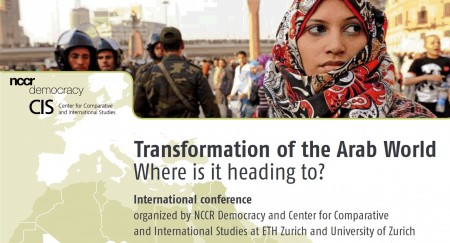
On 27 and 28 October, the NCCR Democracy project managed by the University of Zurich, together with the Center for Comparative and International Studies at ETH, hosted a conference on the topic: “Transformation of the Arab World: Where is it heading to?” Adam Dempsey, Eveline Hoepli, Chantal Chastonay and I covered the event for the ISN.
The conference kicked off on Thursday morning with Roland Popp’s unscheduled presentation, “The Past as Prologue? Regional Dynamics and Revolutionary Trajectories in the Middle East.” Popp, a senior researcher at the Center for Security Studies (CSS) at ETH and an expert in the international history of the Middle East, stressed the importance of looking beyond the unit-level to understand transformation. Citing the example of Egypt’s 1952 revolution, the fear of Arab nationalism it provoked in the other monarchies of the region, and Nasser’s subsequent isolation (which, as we know, ended up driving him closer politically to the United States), he argued that regional dynamics are essential to understanding many developments whose logic at first appears confined to individual countries. Wise counsel, no doubt, and of obvious significance for the remarks that would follow.
Other highlights from the morning included Daniel Ritter, of the European University Institute in Florence, who explained the diverging trajectories of Tunisia and Egypt, on the one hand, and Libya and Syria, on the other, as a consequence of the relative closeness of the former regimes to the West. Steven Heydemann, from ISN’s partner USIP, begged to differ, however, arguing that much more important was the simple fact that the events in Tunisia and Egypt happened first, allowing subsequent regimes to learn from earlier mistakes. Also of note were the presentations of Dr. Saloua Zerhouni, of Mohammed University in Rabat, who examined the changing composition and attitudes of elites across the region, and Mark Tessler, from the University of Michigan, who presented the intriguing results of his public opinion research in 12 Arab countries, which suggest that the attitudes of Arab populations toward democracy and political Islam are far more complicated and interconnected than we might think.
If the theme of Thursday morning was differing Arab experiences in recent months, the theme of the afternoon was non-Arab perspectives on these developments. First were the usual suspects: Shibley Telhami, from the University of Maryland, started by presenting on how the American domestic political background is shaping its response to the Arab Spring, and Menachem Klein then emphasized the non-connection — at least in Israeli eyes — between the Israeli social protests of the summer and the wider spirit engulfing the region. Next up was Professor Elham Manea, from the University of Zurich, who explored how the Shia-Sunni confessional axis — and the regional rivalry between Iran and Saudi Arabia — was influencing developments, before Tina Freyburg, representing both ETH Zurich and EUI Florence, reported on efforts by the European Union to promote democratic governance in the new Arab regimes through a new strategy of functional cooperation.
Friday’s proceedings, by contrast, focused less on the causes of transformation than on its future prospects. Sheila Carapico, from American University in Cairo, argued, in the case of Yemen, that even if the current wave of civic mobilization is not sustained or translated into significant political change, the dramatic shift in the use of public space it occasioned will have a lasting impact on Yemeni civil society and could be a turning point in the nation’s history. Wendy Pearlman, of Northwestern University, then argued that the emotive dimensions of the uprisings — manifested in a change from feelings of fear and powerlessness to those of pride and anger — are at least as important as the material, logistical, or strategic dimensions for understanding their future.
And — just in time for lunch — it was Dr. Nader Fergany, of the Al-Mishkat Center for Research and Training in Cairo, who brought the curtain down on the Conference with the question that to many is the most significant for the recent developments in the Arab world: i.e., whether “the Arab spring” will “bloom” or turn into a “harsh winter.” Though Dr. Fergany remained understandably agnostic on the immediate prospects for “human renaissance in the Arab world … after seven long centuries of decay,” he did express his personal conviction that the original purposes of the revolutions “in freedom, justice, and human dignity for all, are bound to be attained eventually.”
For the full abstracts of all the presentations, see the appropriate section of the Conference website.

